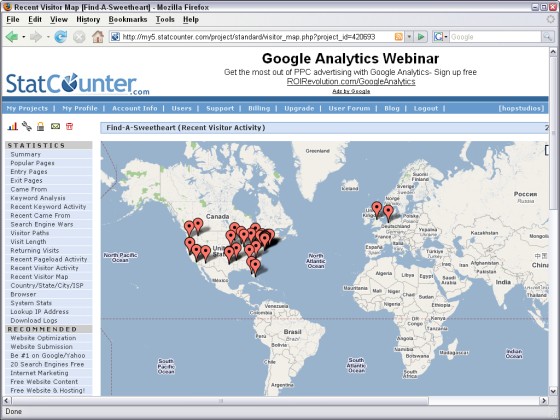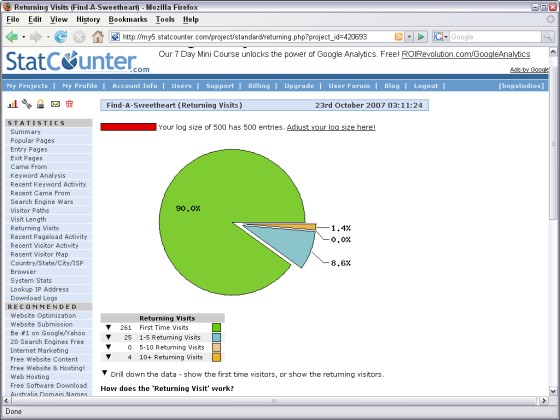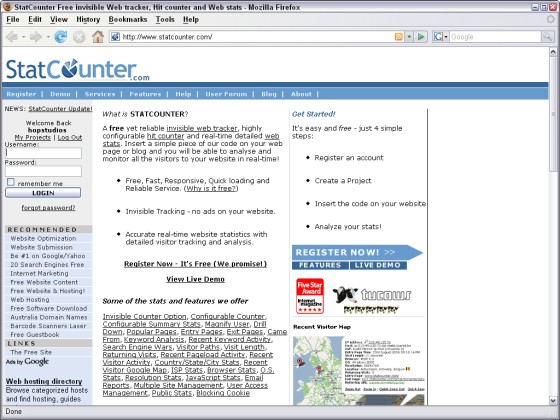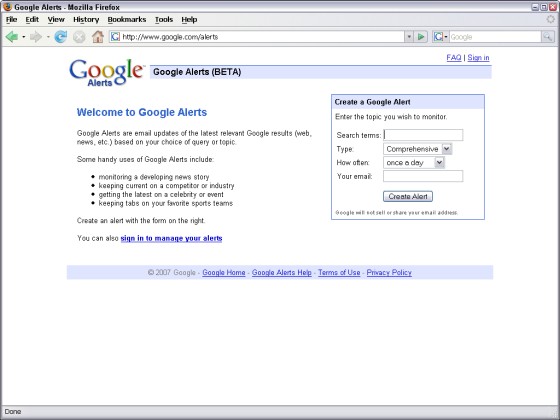In This Chapter
Figuring out what Web statistics tell you
Checking out good statistics tracking tools
Tracking the blogosphere for keywords and topics
For a moment, picture your new blog running just the way you like it. The graphics are pretty, you're blogging every day, and comments are rolling in. Everything looks perfect, and you seem to be well on your way to a successful blogging career. But wait! Now imagine that, for no real reason, over a few weeks the number of comments left on your blog each day starts to decrease. Your visitor numbers are down. There doesn't seem to an obvious explanation, and you can't imagine why your readership is disappearing so quickly!
If you ever find yourself in this type of situation and you don't have any idea why your traffic is changing, you'll start asking yourself questions like “How many visitors do I have every day, anyway?” or “How many of my visitors have been here before?”
For you, it's time to understand your Web traffic statistics. Web stats can be especially important for you as a blogger because your audience numbers are affected each time you post.
Paying attention to what your blog is doing on the Internet is an important task, but it can be confusing and boring. Spending an afternoon peering at Web stats, especially if you don't know what you're looking for, can be a tedious experience. It's like …well, it's like watching paint dry. But, it doesn't have to be as painful as it sounds. Web statistics are very geeky, but these days, services that are available to bloggers (and Webmasters, in general) allow you to track your blog's success in some very interesting and informative ways by using a friendly interface.
For more help with Web analytics, check out Web Analytics For Dummies by Pedro Sostre and Jennifer LeClaire (2007) from Wiley Publishing.
Even if you like the way your blog is performing, you should take a look at your blog stats once in a while. Some bloggers look at them daily to see what kinds of visitors appeared on their blogging radar overnight; some bloggers check their stats once a week or once a month. Whichever pattern you choose, keeping a good handle on your statistics is never a bad thing. Knowing how many visitors you have can help you improve your blog in the future — making it even more popular!
Your Web logs can tell you all kinds of things, and a whole lot more than just how many people read your site. For an example of what a typical Web stats tool looks like, check out StatCounter's measurement of the Find‐A‐Sweetheart Web site (www.find-a-sweetheart.com) in Figure 15-1 . (You have to be logged in to view stats on StatCounter.)
Using Web statistics, you can track:
What countries your Web visitors are surfing from
How long visitors stay
How many visitors are there for the first time
What pages your visitors start their visit on
What pages visitors end their visit on
What sites are sending visitors to you
What search words are being used to find your site
What browsers your visitors use
What kind of computer your visitors use to surf the Web
What screen resolutions your visitors set their monitors to
With some of the more advanced Web analytics software, you can see what pages are the least popular, find out how search engines handle your blog, and even see what errors or missing pages your visitors are getting. Lots of bloggers are especially interested in knowing what Web sites are sending visitors to their blogs, so they know where to invest time and energy in comments and discussion forums.
Knowing even a little bit about your traffic can help you make all kinds of strategic decisions about your blog, from what kind of design to use to the subject of a post.
Web analytics are the trends that your statistical or log software shows you. Some traffic software helps break out these trends for you, but the most basic software simply displays the raw data of how your site is being used and lets you draw the conclusions. When people talk about Web analytics, they're referring to the process you undertake when you're looking through those stats and logs to figure out what visitors are doing on your Web site. Commonly, you look for trends about what content the visitors are viewing, how often they visit, and what other sites are directing traffic your way.
Pay close attention to your Web site logs and you can chart what your users are doing over time. You can see what your site visitors are reading and what keeps them coming back for more. You can then use this information for a variety of purposes (like, say, deciding what to blog about).
For instance, if you notice that a large bunch of readers are coming from a particular country (see Figure 15-2 ) and you don't live in that country, you should see what pages those visitors are viewing — and determine why they're coming to your site. You can then write more to attract additional visitors with similar tastes. In fact, noticing a trend like this one might help you really focus on a core audience you weren't aware of or even redefine what you do with your blog in the future.
You can also break this information into dollars and cents. If you take the time, you can see what kinds of visitors are clicking advertisements on your site (if you have any). If more people are clicking a certain type of advertisement, you can use this information to sell ads to certain advertisers.
To understand what it is you're looking at when you're scanning your Web statistics or server logs, you need to know a series of terms. Most Web analytics software uses these terms, but you should always check to see how measurements are defined by the software's creators — these terms are commonly used the same way, but not always. I cover the most vital terms in the following sections.
You'll run into more terms than the ones I cover here, but the most important ones for bloggers are page views, unique visitors, and repeat visitors. Together, these three statistics give you the most accurate picture of how many visitors your blog receives and what they do while they visit.
A hit is an official request for a file from the Web server. The file can be an HTML file or a movie file. Essentially, any file available on a Web server to the surfing public counts as a hit.
Any given Web page causes multiple hits on the server when it's loaded, even though it's only one page. This is because multiple files are actually being called to display the page: the HTML file, any associated style documents, and all the image files. If an HTML file has five images, it counts as six hits — one for the HTML file and five for each individual image.
Hits are commonly misunderstood to indicate the number of Web site visitors or even the number of pages viewed, but they don't even come close to measuring those kinds of figures. Hits are pretty meaningless if you're trying to understand how many visitors you have, but they can be important if you need to get a feel for the load your site puts on the Web server.
A page view is normally defined as a “page” within a Web server log; if an HTML file is requested, the log says that this is a single request even if several files are needed to display the page. Each time a page of your site is loaded, it counts as a page view, and page views are a valuable measurement because you can get a better understanding for what kind of usage people are making of your site.
In Figure 15-3 , you can see the page loads for October 6, 2007.
Advertisers are often very interested in the number of page views on a Web site (more is better), and most bloggers consider having lots of page views a number to brag about.
Unique visitors are just what they sound like — individual visitors who visit your Web site. They're counted only once, no matter how many pages they view or how many times they visit. When you're looking at the number of unique visitors your blog gets, take a look at what time period is being referred to. Fifty unique visitors in one day, for example, is a much bigger deal than 50 unique visitors in a month.
Repeat visitors are blog readers that visit your site on more than one occasion and, usually, visit multiple pages. Pay attention, again, to the time period being discussed when repeat visitors are measured.
In Figure 15-4 , you can see a graph breaking down the percentages of first‐time visitors to repeat visitors on the Web statistics tool StatCounter.
Most stat software tracks errors, instances when your visitors get an actual error message when they try to do something on your site or when they try to view a page that doesn't exist anymore (or never did).
Track your error logs to find out where visitors are having problems and be sure to fix the errors.
A lack of standards
Currently, no official standards are governing the world of server logs and Web statistics. No large corporations tell anyone how things should be done, what terminology should be used, or how statistics should be analyzed. The world of Web stats has, more or less, grown organically, and a set of rules has built from the community around the analysis of server logs.
There can be a lot of inconsistency in what's measured in different software tools and how it's measured. For instance, I commonly use two different programs to measure unique visitors on my own blog, and the two software programs rarely agree about what that number is. It's a frustrating fact of life. (Don't tell anyone, but I tend to use the bigger number.)
Knowing this, you might want to consider using at least a couple of Web statistics tools (I talk about some options later in this chapter) and comparing the results you are getting. Different Web analytics software treats server logs differently, and some software is certainly better than others. Most often, users find packages that create charts and graphs that represent their data are a better solution. Because no hard and fast rules exist, you're free to do research into what packages will work better for you.
Many statistics software applications for tracking Web traffic are available for installation on your blog. But before you get too carried away, check to see whether your blog host offers Web traffic — tracking software or gives you access to your server logs.
If stat software is part of what your Web host offers you, be sure to review the offerings carefully. You might not need any additional tools, or you might want to supplement the preinstalled tool with one of those discussed in this section, if only to check the accuracy of the numbers you're seeing as much as is possible. Keep in mind that different applications can measure things differently, so the numbers may not be exactly the same.
Some bloggers like to look at the server logs for their sites. Server logs are simple text files that Web servers generate in order to keep track of information about who, when, and how a Web server is visited.
Most Web hosts provide access to stat software and server logs through an administrative control panel.
In the following sections, I cover the different services and software available. You should be able to find a service that fits you.
Web stats can be a difficult thing, and you might want to check them daily. But don't forget you have a blog to run, and that requires a concentration on the quality of the content you produce for your community. Try to avoid an obsession over your Web statistics because no amount of tinkering with Web analytics can make your blog popular. Your content is the only thing that will accomplish that.
Like hosted blog software, hosted Web statistics software is managed by the company that has created the software package. Typically, you install the software by adding a chunk of HTML code to your pages that communicates with the hosted software.
In 2005, Google purchased a software package known as Urchin, created by a Web statistics company. Urchin has since been released as the online stats system Google Analytics
Google Analytics has a great interface with many options that you can customize and use to analyze stats to your heart's content. You can do calculations on visitors by using different criteria such as page views and number of visits. The Google Analytics system is free, but it requires a registered Google Account (which is free as well). To use Google Analytics (shown in Figure 15-5 ), you must be able to place some HTML code into your blog software templates so that it appears on every page you want to track. If you can't access the templates, this won't be an option for you.
StatCounter is a free hosted statistics tracker and is easy for new users, thanks to good organization and explanation in the control panel.
After setting up your site in StatCounter (see Figure 15-6 ), you must insert StatCounter HTML code into your blog templates so that it can track everything from what terms your readers used in search engines to a Google Maps interface of where your traffic originates.
Site Meter has been around since the beginning of stats tracking on the Web. This tool provides you with basic details about each visitor that comes to your blog and shows you what the visitor does while there, even down to what page they are on when they leave.
Site Meter (see Figure 15-7 ) has two levels of service: the free basic edition and the professional edition. The professional edition provides more information than the basic setup and grants to access to a longer history of your statistics, but the free edition is a good starting point for new bloggers. The professional edition starts at $6.95 a month.
Web analytics software that you can install on your Web server and manage on your own is called installable software. If you want to use a specific analytics package your host doesn't normally provide, look into whether you can install software on your server. Some hosts can give you suggestions and may even assist you installing analytics software.
Installed software is usually used to measure the same kinds of things as hosted statistics software, but does so by analyzing log files stored on your Web site, rather than gathering information as a visitor hits your site. Some Web developers feel that these numbers are therefore more accurate, but that's a hotly debated opinion.
When you sign up for a Web‐hosting package, the Web host probably has some kind of Web statistics available to you. These packages can range from open source software to custom, home‐grown solutions.
Be sure to check the technical requirements for the package that you want to install to be sure that your server works with it.
Webalizer is an open source application that you install on your server. Because it's free to use, many Web hosts offer it as part of their standard Web hosting packages. Originally created in 1997, Webalizer lets you track hits, page views, geographical origin of your traffic, and other data.
Webalizer generates easy‐to‐read pages showing traffic broken down by month (see Figure 15-8 ), but you can also see traffic figures by day and even by hour. All the usual suspects are here, from page views to unique visitors to the top referring sites.
http://awstats.sourceforge.net
AWStats is another popular Web statistics analyzer that you can install on your Web server. It has features that allow you to track visitors but also streaming media, e‐mail, and FTP transactions on your server. AWStats requires the Perl programming language to be installed on your Web server to operate. (Most Web servers support this requirement.)
AWStats (see Figure 15-9 ) generates graphs and other visual indicators about the activity of your visitors month by month, letting you see the region and cities where traffic originates, the operating systems, and browsers used by your visitors, among many other measurements.
Mint is a recent entrant into the installable software field, and offers the usual suspects: new and returning visitors, the sites they get to your site from, search terms they use to find you, and so on. Mint also looks really cool, and you'll enjoy using the graphs and charts it produces.
A Mint license costs $30.
Watching the behavior of your site's visitors is important, but you can also find out a lot by monitoring mentions of you, your blog, and your topic on the Web (especially on your competitor's blogs!). Watching what's going on within the blogosphere is a huge task. You could spend hundreds of dollars to have others do it for you, or you could check out some of the simple tools available on the Web.
Blogosphere tools available to you include the following:
E‐mail notifications: Receive updates via e‐mail about content or topics you want to keep up with.
RSS watch lists: Keep current on topics using your favorite newsreader software. (Read more about RSS in Chapter 11.)
You can use these tools in a variety of ways by doing random manual searches and installing software designed to display Web information on your desktop.
The power of RSS and the syndication of news and blog feeds become apparent when you start trying to monitor certain phrases and keywords. RSS is one of the best ways to track what people are saying about your blog and about topics that you're interested in.
Google Alerts (see Figure 15-10 ) are e‐mail notifications that are sent to you based on keyword searches of Google's search system. Sign up for an account and then create an alert by entering keywords you want to be notified about.
In order to receive any e‐mail from the Google Alerts system, you need to enter some keywords.
Go to http://www.google.com/alerts.
Enter the keywords you want to be notified about in the Search terms box.
Select the type of Web content you want included in your search. Your options are news, blogs, web, comprehensive, video, and groups.
Select how often you want to be notified: once a day, as‐it‐happens, or once a week.
Type your e‐mail address into the e‐mail field.
Click Create Alert.
Google begins to track your search and send you e‐mails as you requested.
When a keyword gets a hit, an e‐mail is sent to you with the link. Automatic keyword searches can be done for all Web sites, blogs, video, and Google Groups, or a combination of all four.
These alerts work best when you create a specific and detailed search. Think about how you can refine your search to keep your results to a manageable number. For instance, if you want to track a particular news topic, use several keywords instead of just one. Do use:
knitting sock yarn hand‐dyed
Don't use:
socks
Set Google Alerts to search for your name, your blog name, and any keywords you want to be aware of. Use these alerts to find out when people are talking about you, your blog, or the topics you're covering.
Technorati is a search engine that focuses its energy on blogs and does it very well. Technorati publishes information periodically that gives people who use its service a “status” of the blogosphere. In its analysis, Technorati updates people on the number of blogs that are officially tracked, what trends in conversations have been ongoing throughout a given time period, and what the growth rate of blog technology adoptions has been.
To create watch lists of certain blogs, keywords, and names, you must sign up for a Technorati account (this is free). Once you are a member, you may create your watch lists.
Log in to your Technorati account.
Click on Watchlists link in the navigation bar.
Under Add to Your Watchlist, type the search terms or URL you want to track.
Click Add.
A watchlist with results appears.
Click the blog post you want to read.
You can manage your watch list using the handy menu items on each watch list. Use these to view all the results for the watch list, open the list in a pop‐up window, subscribe to the watch list via RSS, or remove the watch list. You can add more watch lists by repeating these steps.
My Watchlist for my name (susannah gardner) is shown in Figure 15-11 .
One of the really nice services offered by Technorati is the ability to subscribe to an RSS feed of your Watchlist terms. Anytime you see the small RSS icon next to the word Subscribe at the top of your Watchlist, you can add the feed to whatever newsreader you normally use to track your Watchlist as you read other blogs!









